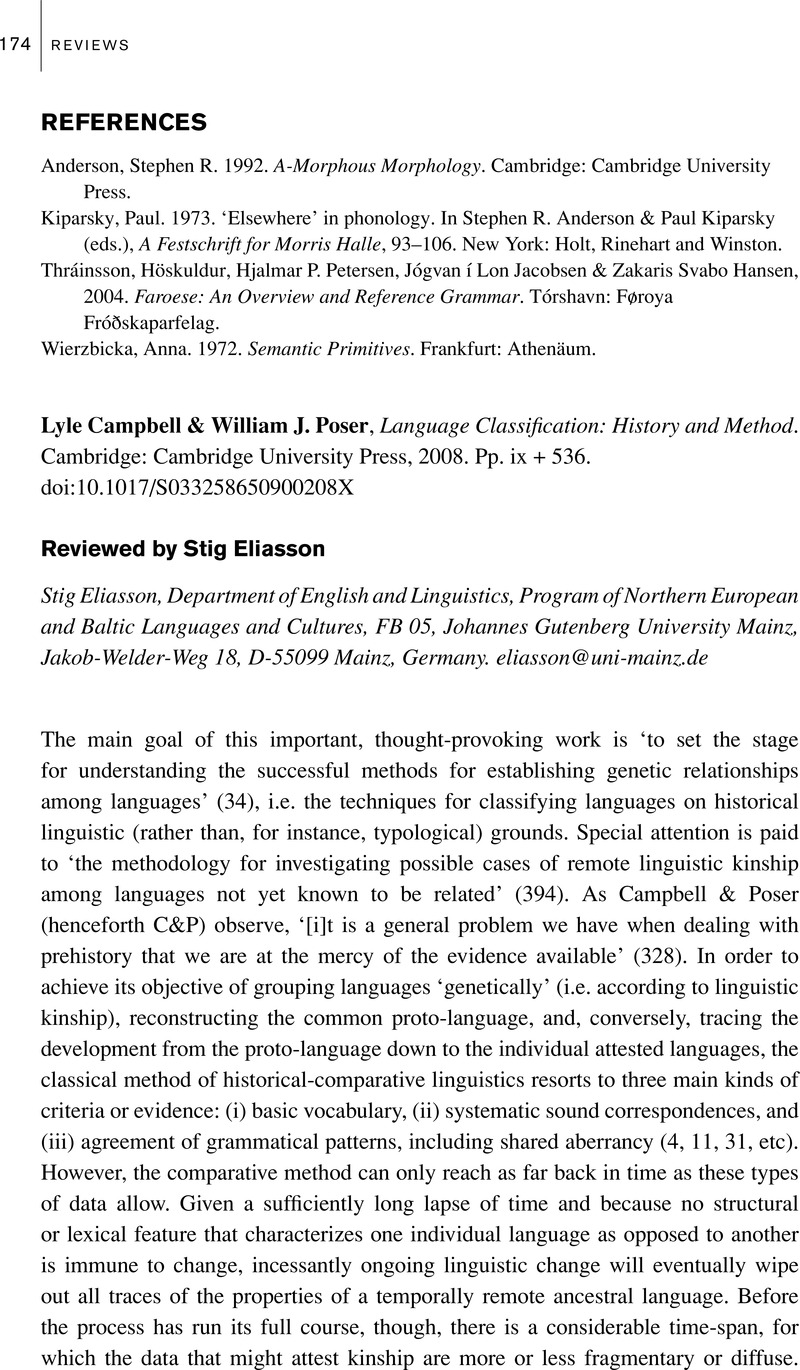No CrossRef data available.
Article contents
Lyle Campbell & William J. Poser, Language Classification: History and Method. Cambridge: Cambridge University Press, 2008. Pp. ix + 536.
Review products
Lyle Campbell & William J. Poser, Language Classification: History and Method. Cambridge: Cambridge University Press, 2008. Pp. ix + 536.
Published online by Cambridge University Press: 01 June 2009
Abstract
An abstract is not available for this content so a preview has been provided. Please use the Get access link above for information on how to access this content.

- Type
- Book Review
- Information
- Copyright
- Copyright © Nordic Association of Linguistics 2009
References
REFERENCES
Bender, Marvin Lionel. 1969. Chance CVC correspondences in unrelated languages. Language 45, 519–531.CrossRefGoogle Scholar
Campbell, Lyle. 2007. Why Sir William Jones got it all wrong, or Jones’ role in how to establish language families. In Lakarra, Joseba A. & Hualde, José Ignacio (eds.), Studies in Basque and Historical Linguistics in Memory of R. L. Trask/R. L. Trasken oroitzapenetan ikerketak euskalaritzaz eta hizkuntzalaritza historikoaz (Anuario del Seminario de Filología Vasca “Julio de Urquijo”, XL: 1–2 (2006)), 245–264. Donostia/San Sebastián: Gipuzkoako Foru Aldundia/Diputación Foral de Gipuzkoa & Bilbo/Bilbao: Euskal Herriko Unibertsitatea/Universidad del País Vasco.Google Scholar
Dixon, R. M. W. 1997. The Rise and Fall of Languages. Cambridge: Cambridge University Press.CrossRefGoogle Scholar
Lejeune, Michel. 1974. Manuel de la langue vénète. Heidelberg: Carl Winter Universitätsverlag.Google Scholar
Morvan, Michel. 1996. Les origines linguistiques du basque. Bordeaux: Presses Universitaires de Bordeaux.Google Scholar
Ngata, Hōri M. 1993. English–Maori Dictionary. Whanganui ā Tara: Te Pou Taki Kōrero/Wellington: Learning Media.Google Scholar
Nichols, Johanna. 1992. Linguistic Diversity in Space and Time. Chicago: University of Chicago Press.CrossRefGoogle Scholar
RingeDonald A., Jr. Donald A., Jr. 1999. How hard is it to match CVC-roots? Transactions of the Philological Society 97, 213–244.CrossRefGoogle Scholar
Robbeets, Martine I. 2005. Is Japanese Related to Korean, Tungusic, Mongolic and Turkic? (Turcologica 64). Wiesbaden: Harrassowitz Verlag.Google Scholar
Vennemann, Theo. 2003. Europa Vasconica–Europa Semitica (Trends in Linguistics, Studies and Monographs 138). Berlin: Mouton de Gruyter.CrossRefGoogle Scholar
Williams, Herbert W. 1971. A Dictionary of the Maori Language, 7th edn. Wellington: A. R. Shearer, Government Printer.Google Scholar


